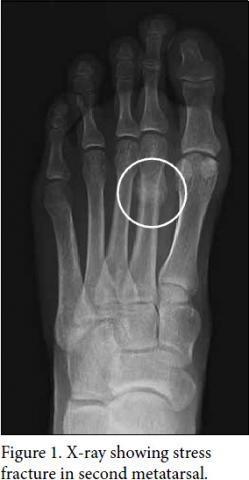Stress fractures of the foot
Text from American Academy of Orthopaedic Surgeons.
 Stress fractures often develop from overuse, such as from high-impact sports like distance running, tennis, track and field, gymnastics, dance, and basketball. When muscles are overtired, they are no longer able to lessen the shock of repeated impacts. When this happens, the muscles transfer the stress to the bones. This can create small cracks or fractures. Most stress fractures occur in the weight-bearing bones of the foot and lower leg, the most common being the second and third metatarsals. Female athletes are more prone to stress fractures than their male counterparts are.
Stress fractures often develop from overuse, such as from high-impact sports like distance running, tennis, track and field, gymnastics, dance, and basketball. When muscles are overtired, they are no longer able to lessen the shock of repeated impacts. When this happens, the muscles transfer the stress to the bones. This can create small cracks or fractures. Most stress fractures occur in the weight-bearing bones of the foot and lower leg, the most common being the second and third metatarsals. Female athletes are more prone to stress fractures than their male counterparts are.
Cause
Stress fractures usually occur when you increase your high-impact activity by: frequency (how often you exercise), duration (how long you exercise) and intensity (your level of exertion).
Doing too much too soon is a common cause of stress fractures. For example, runners who are confined indoors for the winter may want to pick up where they left off at the end of the previous season. Because of the lower level of conditioning, muscles become fatigued faster. The result could be a stress fracture in the foot or ankle.
Improper sports equipment, such as shoes that are too worn or stiff, can contribute to stress fractures. A change of surface can also increase the risk.
Technique: anything that alters the mechanics of how the foot absorbs impact when it strikes the ground may increase your risk for a stress fracture.
Symptoms and diagnosis
1. Pain that develops gradually, increases with weight-bearing activity, and diminishes with rest.
2.Pain that becomes more severe and occurs during normal, daily activities.
3.Swelling on the top of the foot or the outside of the ankle.
4.Tenderness to touch at the site of the fracture.
5.Possible bruising.
Imaging tests may help your doctor confirm your diagnosis. However, stress fractures are difficult to see on X-rays until they have actually started to heal.
Treatment
1.First Aid. If you suspect a stress fracture in your foot or ankle, stop the activity and rest. Ignoring the pain can have serious consequences. The bone may break completely. Apply an ice pack and elevate your foot above the level of your heart. Nonsteroidal anti-inflammatory medicines like ibuprofen or naproxen may help relieve pain and swelling, but may inhibit bone healing. Try not to put weight on your foot until after you see a health care provider.
2. Rest. Take a break from the activity that caused the stress fracture. It typically takes 6 to 8 weeks for a stress fracture to heal. During that time, switch to aerobic activities that place less stress on your foot and leg. Swimming and cycling are good alternative activities.
Protective footwear, cast and crutches. To reduce stress on your foot and leg, your doctor may recommend wearing protective footwear, like a removable short-leg fracture brace shoe. In certain cases, a cast and/or crutches may be necessary. Some stress fractures can also require surgery to heal properly
Recovery and prevention
Once your stress fracture has healed and you are pain-free, you will be allowed to gradually return to activity.
Slow pace. During the early phase of rehabilitation, it will be recommended to alternate days of activity with days of rest. You should slowly increase the frequency, duration, and intensity of your exercise.
Cross-training. Varying the types of aerobic exercise you do may help you avoid repeated stress on your foot and ankle. Start any new sports activity slowly. Your health care provider may prescribe orthotics if you are an overpronator.
Maintain a healthful diet. Eat calcium and Vitamin D-rich foods to help build bone strength. Use proper sports equipment. Don't wear old or worn running shoes. . Gradually increase time, speed, and distance; a 10% increase per week is fine. If pain or swelling returns, stop the activity. Rest for a few days. If pain continues, see your health care professional.



